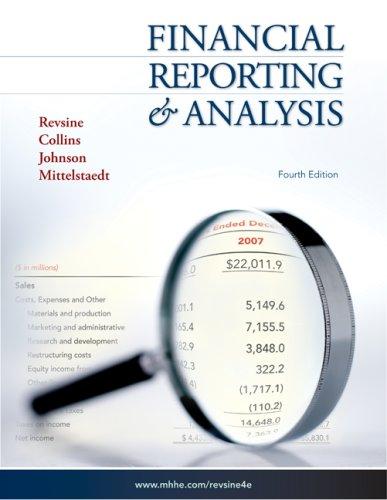National Sweetener Company owns the patent to the artificial sweetener known as Supersweet. Assume that National Sweetener
Question:
National Sweetener Company owns the patent to the artificial sweetener known as Supersweet.
Assume that National Sweetener acquired the patent on January 1, 2002 at a cost of \($300\) million dollars, expected the patent to have an economic useful life of 12 years, and has been amortizing the patent on a straight-line basis. Assume that when the patent was acquired, National Sweetener expected that the process would generate future net cash flows of \($30\) million the first year of its useful life and that the cash flows would increase at a 10% rate each year over the remainder of its useful life. By the year 2014 that is, after 12 years, National Sweetener expected that several other artificial sweeteners would be on the market and therefore that it would sell the Supersweet patent then for about \($60.0\) million.

On December 31, 2008 when the patent’s book value was \($160.0\) million \($300.0\) — \($140.0\),
National\) Sweetener learned that one of its competitors had developed a revolutionary new
sweetener that could be produced much more economically than Supersweet. National Sweetener
expects that the introduction of this product on January 1, 2009 will substantially reduce
the cash flows from its Supersweet patent process.
Consider the following two independent scenarios:
Scenario I: National Sweetener expects that the cash flows from Supersweet over the period 2009-
2013 will be only 50% of those originally projected and that the sale of the Supersweet patent will bring only \($25\) million when sold. When discounted at a rate of 15% (which National Sweetener feels is appropriate), these amounts yield a present value of \($129.0\) million. National Sweetener estimates that the market value of the Supersweet patent on December 31, 2008 is \($160.0\) million.
Scenario II: National Sweetener expects that the cash flows from Supersweet over the period 2009-2013 will be only 25% of those originally projected and that the sale of the Supersweet patent will bring only \($25\) million when sold. When discounted at a rate of 15%, these amounts yield a present value of \($70.7\) million. National Sweetener estimates that the market value of the Supersweet patent on December 31, 2008 is \($68.0\) million.
Required:
1. Should National Sweetener recognize an impairment of its Supersweet patent in Scenario I?
If so, what is the amount of the loss and at what amount should the patent be reported in National Sweetener’s 2008 ending balance sheet?
2. Repeat requirement 1 for the second scenario.
Step by Step Answer:






